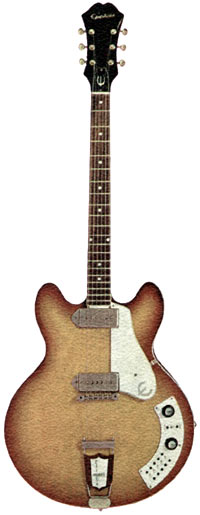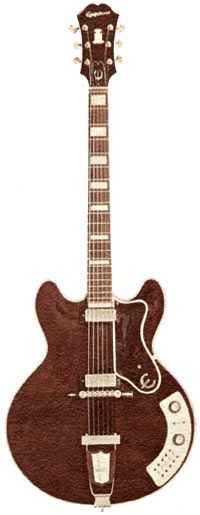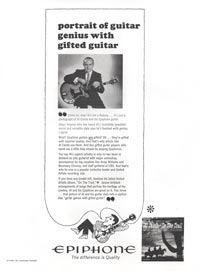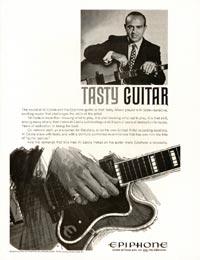

Epiphone Al Caiola Standard

Epiphone Al Caiola Custom
Since the late 1950s, but increasingly in the early 1960s, Gibson introduced a number of artist models; typically high-end jazz guitars, designed in conjunction with popular artists of the time. These guitars were typically the most expensive models, produced in small numbers by the Custom shop at the Kalamazoo plant.
Prior to Gibson's acquisition of Epiphone, the company had no artist signature models, but when production moved to Kalamazoo the brand started to align itself more closely with Gibson's output. The Al Caiola was their first US-built signature electric, preceding the only other, the Howard Roberts by one year.
Al Caiola was a popular artist with a long career as a session musician, band leader and solo guitarist, and had been associated with Epiphone for some years. His jazz, pop and western style music was very popular amongst a certain (older?) section of American society in the early 1960s. In 1963, he was pictured in an advertisement for the brand with an Epiphone Casino, but by the end of this year the first version of his signature 'Caiola' guitar was in production. It was a fine thinline electric acoustic, priced approximately in line with the Epiphone Sheraton, with a launch price of $525 (compared to $545 for the non-vibrato Sheraton).
In terms of specification, it was quite an interesting model, with it's unique 'Tonexpressor' tone switches. It had the same body width and length as the Casino, but was a shade (3/16") deeper at 1 15/16", though with a longer 25 1/2" scale, and was fitted with Epiphone mini humbuckers. It had the Epiphone 'i' headstock inlays aswell as inlaid logo and block position markers.
The guitar was available between 1963 and 1969, but was renamed the Al Caiola Custom, when a slightly simplified model, the the Al Caiola Standard was launched in 1966. The Standard had simpler inlays; just the Epiphone logo and dot markers, plus metal covered P90 pickups. The initial price for the Standard (October 1966) was $420 - at which point the Custom was $585.
Available finishes were Royal Tan (two colour red/yellow sunburst), Shaded (three colour black/red/yellow sunburst), Cherry and Walnut. The Custom was never listed as available in Cherry finish, though examples exist. Shipping numbers, unfortunately, do not specify finish.
The Caiola shipping figures are not split by finish colours, as with some other models. 1967 was the peak year, in terms of shipping, with over 40% of all Customs, and almost 70% of all Standards shipped that year.
| 1963 | 1964 | 1965 | 1966 | 1967 | 1968 | 1969 | total | |
| Al Caiola / Al Caiola Custom | 2 | 30 | 47 | 23 | 102 | 13 | 13 | 230 |
| Al Caiola Standard | 8 | 116 | 24 | 18 | 166 |
1964 full line catalogue
The 1964 catalogue was the first to show the Epiphone Caiola. This model was renamed the Caiola Custom in 1966.
1966 full line catalogue
“Today the electric Spanish guitar is found everywhere... orchestras, combos, jazz bands and as a featured solo instrument. Epiphone electric Spanish guitars suit the need of every player, from the top professional, to the semi-pro, to the amateur”
Electric guitar advertisements originally published from 1965 onwards. Click on the images for larger copies. Check out other vintage Epiphone advertisements

Epiphone Caiola - Portrait of Guitar Genius with Gifted Guitar (1965)
The first advertisement for the new Al Caiola guitars featuring the Al Caiola Custom. Caiola had been a Gibson endorser for some years, previously being pictured with the Epiphone Casino, but in 19...
[more]

Epiphone Caiola - Tasty Guitar (1966)
Mid-sixties Epiphone advert for the Caiola; a guitar named after, and produced for, Artist Al Caiola.
The sound of Al Caiola and his Epiphone guitar is that: tasty. Music played with taste -...
[more]
£8995